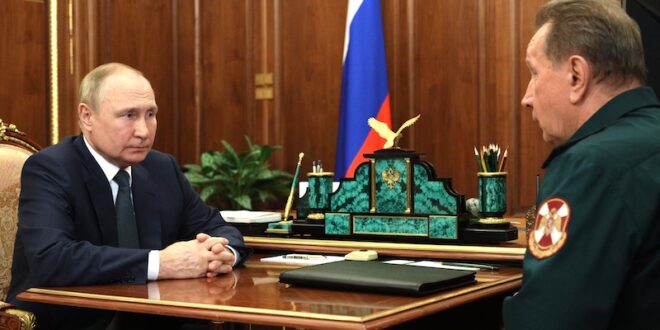- Reshuffling of the Russian High Command and the Syria Failure
Russia was prepared for a two-week special operation—a larger version of the 2014 invasion of Crimea that stunned the Western strategic community. Vladimir Putin, relying on Russian Chief of the General Staff Valery Gerasimov’s hybrid warfare tactics, expected to achieve his strategic objective without breaking the threshold of state-on-state conflict.
Almost 17 months later, Russia finds itself in a protracted war. NATO members have initiated the most comprehensive multinational military assistance campaign of the twenty-first century, and Ukrainian morale remains high.
As the invasion stumbled, Putin held anyone but himself responsible. The Russian system, with its Stalinist roots, is designed to maintain the leader’s authority and shield him from accountability. Generals became scapegoats for the former KGB officer’s failures.
The rapid reshuffling of commanders demonstrates the quick political reflexes of the Russian security apparatus, as well as the Kremlin’s grave concern about the state of the invasion. The Western Military District had four commanders between February and December of 2022: General Yevgeny Nikiforov, General Sergey Kuzovlev, General Roman Berdnikov, and General Aleksandr Zhuravlev.
In the Eastern Military District, General Alexander Chaiko, General Gennady Zidhko, and General Rustam Muradov have held command since the invasion began.
The Central Military District has also had three leaders: General Alexander Lapin, General Alexander Linkov, and General Andrey Mordvichev.
Finally, the Southern Military District has had two commanders. One was General Alexander Dvornikov, who was the first commander of the Syrian expedition in 2015.
Putin not only lacks faith in his generals’ military skills, but he also seeks to remind the generals that they are expendable in spite of their highly decorated uniforms. Meanwhile, Gerasimov and Defense Minister Sergei Shoigu have remained in command despite their failures. They serve as an important example: the siloviki favor political loyalty over warfighting capability.
Setbacks in Ukraine have demonstrated Russian military leaders’ unpreparedness for large-scale international conflict. These generals hail from the last generation of the Soviet Red Army, and most saw combat action as young officers in the Russo-Chechen Wars.
The Russian generals’ ineffectiveness unveiled another bitter truth: the Syrian expedition did not produce the boost Putin had hoped. Russia rotated thousands of personnel, including military district commanders, through combat tours in Syria to gain large-scale conventional conflict experience.
These tours did not deliver the desired result for three reasons. First, the Syrian Arab Army, along with the paramilitaries organized by then-Quds Forces Commander General Qasem Soleimani, provided the Russian coalition with the needed land forces. Second, the Russian military never had to conduct major conventional operations in Syria, such as suppression of enemy air defenses (SEAD) or combined arms maneuver warfare at the division, corps, or army level. Third, the Russian naval component in Tartous enjoyed complete freedom of navigation. This is in sharp contrast to the Black Sea Fleet’s current troubles, exemplified by the sinking of its flagship, the missile cruiser Moskva.
- Warlords Have Found Room for Political Maneuvering
As the Kremlin reshuffled generals, Russia’s rising warlords—Wagner chief Yevgeny Prigozhin and Chechen strongman Ramazan Kadyrov—saw an opportunity. The two figures wielded their influence through Telegram and other channels to praise or degrade Russian generals.
Prigozhin often lauded General Sergei Surovikin of the Aerospace Forces and General Mikhail Teplinksy of the Airborne Forces (VDV). He also called Gerasimov an alcoholic and demanded that the Kremlin execute Shoigu and Gerasimov. Kadyrov harshly criticizedGeneral Alexander Lapin for his ineptitude. Shortly after—and perhaps coincidentally—General Lapin was removed from his post.
As the Russian leadership’s need for troops grew, so did mercenary and paramilitary groups’ political leverage. The Ministry of Defense (MoD) recently attempted to rein in these power-hungry warlords by forcing them to sign contracts that conscript their troops into the regular armed forces. But the MoD’s problems run much deeper. With the Ukrainian counteroffensive in sight, the Armed Forces of the Russian Federation needs to maintain a reliable force-to-force and force-to-terrain ratio. Put simply, Russia needs every triggerman available to fight in Ukraine. Contracted or not, volunteers, paramilitaries, and private military companies will keep operating alongside the Russian military.
- What’s Next?
At the time of this writing, news suggests that the Wagner mutiny might have been a deeper plot than it initially seemed. High-ranking military figures, including General Sergei Surovikin, may have been involved. Whether or not these claims are accurate, they demonstrate the textbook paranoia of any tyrant.
Here are three changes to look for in Putin’s Russia:
First, the Federal Security Service (FSB) will exercise tighter control over the nation and those in positions of power.
Second, Putin is likely to further empower his personal guard, the Rosgvardya, commanded by General Viktor Zolotov. General Zolotov is currently the only high-ranking officer who enjoys Putin’s complete political confidence.
Third, the Russian military’s Main Military-Political Directorate might play a more prominent role. The directorate controls the armed forces’ ideological and political direction. In a military structured around political loyalty, such mechanisms to ensure allegiance are vitally important. The Kremlin appointed General Viktor Goremykin to run the directorate. Goremykin is a noteworthy general, and available information suggests that he was a counterintelligence officer working with the FSB while in charge of the Russian military’s personnel directorate for the past decade. His appointment suggests Putin’s insecurity.
There is one final wildcard scenario worth considering. The content of Prigozhin’s deal with the Kremlin is unknown. The Wagner chief waged an armed mutiny in Russia, drove hundreds of kilometers to the gates of the capital, downed seven aircraft, and got away with it. He has several potential allies within the regime. Thus, it remains possible that Putin agreed to a major transfer of power in his deal with Prigozhin.
 Eurasia Press & News
Eurasia Press & News



